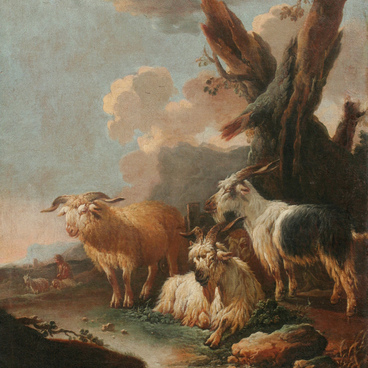According to various sources, Jacopo Palma il Giovane (“Palma the Younger”) was born in Venice in 1544, 1548, or 1550 into the family of the artist Antonio Negretti. He was the great-nephew of the famous painter Jacopo Palma il Vecchio (“Palma the Elder”).
Palma il Giovane left behind a huge number of paintings. His works can be found in museums throughout Italy and beyond. These paintings are hard to date; it is therefore extremely difficult to trace how the master’s work developed.
At first, the young artist studied painting in Urbino, and at the age of fifteen, he came to Rome, where he studied mainly chiaroscuro engraving with Polidoro da Caravaggio and copied the works of Michelangelo and Raphael.
In 1570, he returned to Venice and became a pupil of Titian. The artist was so successful in following the manner of the great master of the Italian Renaissance that after his death, he finished the famous painting “Mourning for Christ”. Palma il Giovane quickly got into the artist’s circle, and his friendship with the leading Venetian sculptor Alessandro Vittoria provided him with clients. The fame of the painter spread beyond the city and brought numerous orders from Central Europe — even from Emperor Rudolf II. Jacopo managed to completely outshine his great-uncle.
Today, the attitude of researchers to the work of Jacopo il Giovane is ambiguous. He is often reproached for the lack of imaginative power and fiery colors, which we see in Tintoretto. However, researchers do praise his works for resourcefulness in composition, the beauty of tone, and attention to drawing.
During his stay in Rome, the artist became imbued with the ideas of mannerism and worked in the style until the end of his life. In the painting “Expulsion from the Garden of Eden”, this was reflected in the desire to make a complex, spectacular composition. According to the Old Testament, Eve, tempted by the Serpent, persuaded Adam to eat the forbidden fruit from the Tree of Life. The first people learned good and evil, violated the will of God, and were expelled from Paradise. The characters are presented dynamically: Adam and Eve are not just leaving Paradise — they are being driven away by an angel. The figures of the characters are moving from a single point in the lower left corner — from here smooth lines tend upwards, creating the outlines of the characters.
Palma il Giovane left behind a huge number of paintings. His works can be found in museums throughout Italy and beyond. These paintings are hard to date; it is therefore extremely difficult to trace how the master’s work developed.
At first, the young artist studied painting in Urbino, and at the age of fifteen, he came to Rome, where he studied mainly chiaroscuro engraving with Polidoro da Caravaggio and copied the works of Michelangelo and Raphael.
In 1570, he returned to Venice and became a pupil of Titian. The artist was so successful in following the manner of the great master of the Italian Renaissance that after his death, he finished the famous painting “Mourning for Christ”. Palma il Giovane quickly got into the artist’s circle, and his friendship with the leading Venetian sculptor Alessandro Vittoria provided him with clients. The fame of the painter spread beyond the city and brought numerous orders from Central Europe — even from Emperor Rudolf II. Jacopo managed to completely outshine his great-uncle.
Today, the attitude of researchers to the work of Jacopo il Giovane is ambiguous. He is often reproached for the lack of imaginative power and fiery colors, which we see in Tintoretto. However, researchers do praise his works for resourcefulness in composition, the beauty of tone, and attention to drawing.
During his stay in Rome, the artist became imbued with the ideas of mannerism and worked in the style until the end of his life. In the painting “Expulsion from the Garden of Eden”, this was reflected in the desire to make a complex, spectacular composition. According to the Old Testament, Eve, tempted by the Serpent, persuaded Adam to eat the forbidden fruit from the Tree of Life. The first people learned good and evil, violated the will of God, and were expelled from Paradise. The characters are presented dynamically: Adam and Eve are not just leaving Paradise — they are being driven away by an angel. The figures of the characters are moving from a single point in the lower left corner — from here smooth lines tend upwards, creating the outlines of the characters.


